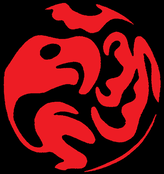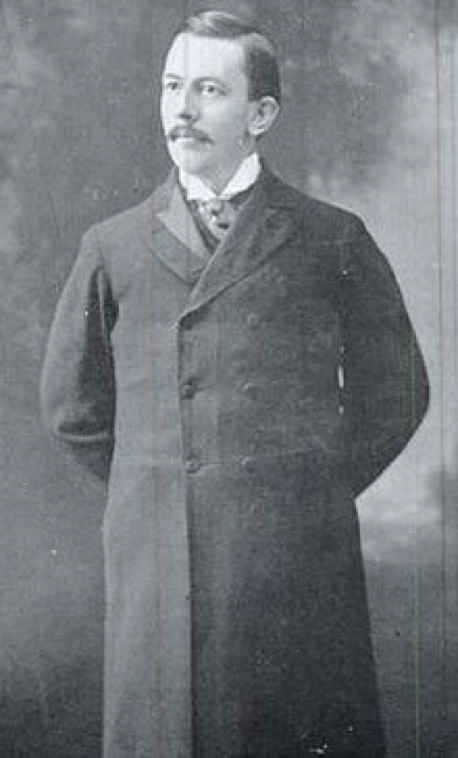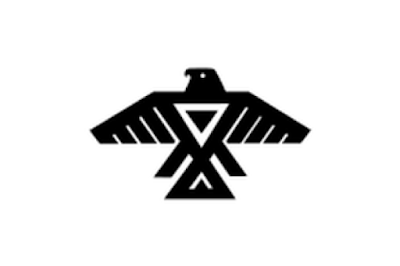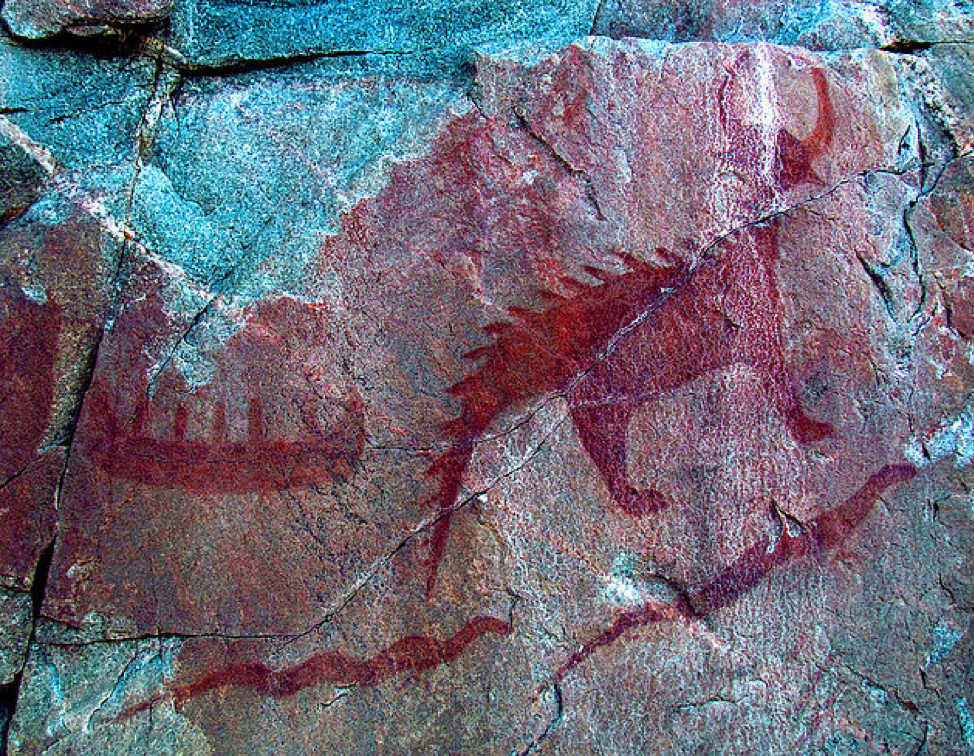|
Among the most remarkable artifacts of the mound builders are the copper effigy antler headdresses. The most famous of these objects have been found at sites of the Hopewell Culture in Southern Ohio. Warren K. Moorehead documented the discovery of two copper antler headdresses in Mound 25 of the Hopewell Mound Group in Ross County. One of these was discovered with the remarkable Burial 248: The skeleton, which was badly decayed, was 5 feet, 11 inches long. Associated with it were some very remarkable objects. At the right shoulder lay a large platform pipe and a beautiful agate spear-head. A copper plate lay on the breast, and another on the abdomen, while a third lay under the hips…Cut, sawed and split bears’ teeth covered the chest and abdomen, and several spool-shaped ornaments and buttons of copper were found among the ribs. The body had apparently been dressed in a cloth garment, extending from the neck to the knees, upon which had been sewn several thousand beads, some of pearl and others of shell. Upon the skirt of the garment had been sewn some of the largest and most beautiful pearl beads found in any of the mounds, together with bears’ teeth, etc. The head had been decorated with a remarkable head-dress of wood and copper…The mass of copper in the centre was originally in the form of a semi-circle reaching from the lower jaw to the crown of the head…The antler-shaped ornaments were made of wood encased in sheets of copper, one-sixteenth of an inch thick. They originally had four prongs of nearly equal length. (Warren K. Moorehead, The Hopewell Mound Group of Ohio, Field Museum of Natural History, Chicago, 1922.), p. 107 The newspapers of the 19th and early 20th centuries sometimes misreported these discoveries as “skeletons with horns”, and these faulty accounts have been routinely reprinted in recent years, causing some to believe that literal horned giants were found in some of the mounds. Although there were no horned giants, the antler headdresses are fascinating objects, and their true meaning and purpose will be explored in the upcoming sequel to Ages of the Giants. For detailed photograph of Mound 25 artifacts, click here.
0 Comments
A Battle between the Thunderbirds and the Great Water Serpents as witnessed by the Lakota Sioux:
“Some of these ancient people still dwell in the clouds. They have large curved beaks, resembling bison humps, their voices are loud, they do not open their eyes wide except when they make lightning, and they have wings. They can kill various mysterious beings, as well as human beings. Their ancient foes were the giant rattlesnakes, and the Un-kche-ghi-la, or water monsters, whose bones are now found in the bluffs of Nebraska and Dakota. Long ago, the Tetons encamped by a deep lake, whose shore was inclosed by very high cliffs. They noticed that at night, even when there was no breeze, the water in the middle of the lake was constantly roaring. When one gazed in that direction he saw a huge eye as bright as the sun, which caused him to vomit something resembling black earth moistened with water, and death soon followed. That very night the Thunderers came, and the crashing sounds were so terrible that many people fainted. The next morning the shore was covered with the bodies of all kinds of fish, some of which were larger than men, and there were also some huge serpents. The water monster which the Thunderers fought resembled a rattle snake, but he had short legs and rusty-yellow fur.” --J. Owen Dorsey, “Teton Folk-Lore Notes”, The Journal of American Folklore, Vol. 2 No. 5, 1889, pp. 133-139. The cosmos of the ancient Earthworks Cultures of the Eastern Woodlands was a layer-cake type of division of realms. The three most important divisions were the Sky World above, the Earth Disc where all humans, plants, animals, etc. live (aka “Earth”), and the Underworld.
The Underworld was a watery place inhabited by powerful entities depicted by both ancient and historic Native Americans as Great Horned Serpents or Underwater Panthers. These beings were ruled by a singular chief of the Underworld Powers, known by a number of names. As explained by the great ethnographer and archaeologist George Lankford: "The most widely recognized form of the underwater powers, however, is the Horned Water Serpent. It is frequently referred to as a single creature, but more careful reading through the collections indicates that the Underwater Panther/Horned Water Serpent is really understood to be a race of people, representatives of which may be encountered in any large body of water, whether seas, lakes, or rivers. Even so, there is still frequent reference to a “master” of the underwater powers." (1, p. 109) Since the Native American cosmos does not draw artificial barriers between the three realms and considered them interconnected, the Underworld powers could—and did—access the Earth Disc. The Great Serpents emerged from streams, lakes, springs, and caves. They were usually dangerous to man, causing drowning, floods, and other calamities, but they could also offer powerful magical abilities. This tradition is still alive today, as many Native medicine societies maintain some type of connection to the Master of the Great Serpents. There is an account of an actual sighting of the Great Serpent/Underwater Panther by the Sioux in the Missouri River, recorded in the late 1800s: “Long ago the people saw a strange thing in the Missouri River. At night there was some red object, shining like fire, making the water roar as it passed up stream. Should anyone see the monster by daylight he became crazy soon after, writhing as if with pain, and dying. One man who said that he saw the monster described it thus: It has red hair all over, and one eye. A horn is in the middle of its forehead, and its body resembles that of a buffalo. Its backbone is like a cross-cut saw, it is flat and notched like a saw or cog-wheel. When one sees it he gets bewildered, and his eyes close at once. He is crazy for a day, and then he dies. The Tetons think that this monster is still in the river, and they call it ‘Mi-ni-wa-tu’, or sea monster. They think that it causes the ice on the river to break up in the spring of the year.” (1, pp. 115-116) References 1. George E. Lankford, “The Great Serpent in Eastern North America”, Ancient Objects and Sacred Realms: Interpretations of Mississippian Iconography, ed. F. Kent Reilly and James F. Garber, University of Texas Press, Austin, 2007, pp. 107-135. |
About UsWe are explorers of cosmology, anthropology, philosophy, medicine, and religion. Archives
October 2020
Categories
All
|
Photo used under Creative Commons from John Brighenti




 RSS Feed
RSS Feed
